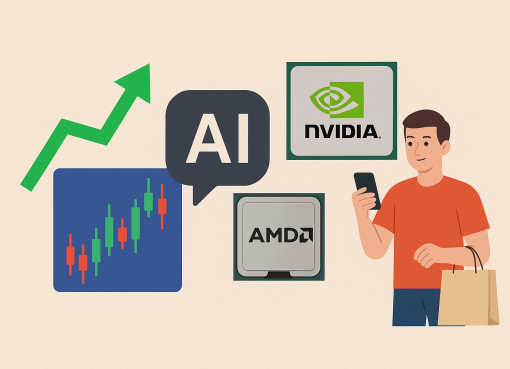Introduction
As the AI sector continues to evolve, major tech companies like Nvidia, Alphabet, and Microsoft have recently experienced significant declines. While these giants have been at the forefront of AI development, their recent performance suggests a need for investors to explore safer alternatives within the AI landscape. This article delves into the reasons behind the downturn of these tech giants and presents safer investment options for those looking to capitalize on the AI boom.
The Current Scenario
Nvidia, Alphabet, and Microsoft have long been synonymous with technological innovation and AI advancements. However, the past month has seen a notable decline in their stock performance. Several factors contribute to this downturn:
Market Overvaluation: The stock prices of these companies have surged over the past few years, leading to concerns about overvaluation. Investors are becoming wary of the inflated valuations, which may not be sustainable in the long run.
Economic Uncertainty: The broader economic landscape, marked by inflation, rising interest rates, and geopolitical tensions, has created an environment of uncertainty. This has prompted investors to adopt a more cautious approach, impacting tech stocks.
Regulatory Scrutiny: Increased regulatory scrutiny, particularly on data privacy and antitrust issues, has put pressure on these tech giants. This has led to concerns about potential fines, restrictions, and operational disruptions.
Safer Investment Alternatives In AI
Despite the challenges faced by Nvidia, Alphabet, and Microsoft, the AI sector remains promising. Investors seeking to navigate this space can consider safer alternatives that offer stability and growth potential without the volatility associated with major tech stocks. Here are some recommended options:
AI-Focused ETFs (Exchange-Traded Funds)
Global X Robotics & Artificial Intelligence ETF (BOTZ): This ETF provides exposure to companies involved in robotics and AI across various sectors. It offers diversification, reducing the risk associated with individual stocks.
iShares Robotics and Artificial Intelligence ETF (IRBO): Another excellent option, IRBO invests in global companies at the forefront of AI and robotics innovation.
Mid-Cap AI Companies
C3.ai (AI): A leading enterprise AI software provider, C3.ai offers solutions that help organizations accelerate digital transformation. Its focus on enterprise applications provides a stable revenue stream.
Palantir Technologies (PLTR): Specializing in big data analytics, Palantir’s AI-driven solutions are used by governments and enterprises worldwide. Its unique position in the market makes it a compelling investment.
AI Infrastructure Providers
Arista Networks (ANET): As a key player in cloud networking solutions, Arista Networks provides the infrastructure necessary for AI applications. Its robust financials and growth prospects make it a safer bet.
Twilio (TWLO): Known for its cloud communications platform, Twilio’s AI-driven solutions are crucial for businesses looking to enhance customer engagement. Its diversified product portfolio reduces risk.
AI in Healthcare
Intuitive Surgical (ISRG): A pioneer in robotic-assisted surgery, Intuitive Surgical’s AI-driven systems are revolutionizing healthcare. The demand for minimally invasive procedures ensures steady growth.
Teladoc Health (TDOC): Leveraging AI for telehealth services, Teladoc Health is well-positioned to benefit from the growing trend of remote healthcare. Its innovative approach makes it a promising investment.
Diversification: The Key To Mitigating Risk
One of the most effective strategies for mitigating risk in AI investments is diversification. By spreading investments across different sectors and companies, investors can reduce the impact of any single stock’s poor performance. Here are some diversification tips:
Sector Diversification: Invest in AI companies across various sectors such as healthcare, finance, and manufacturing. This reduces exposure to sector-specific risks.
Geographic Diversification: Consider AI companies based in different regions. This helps mitigate risks associated with regulatory changes and economic conditions in a specific country.
Investment Vehicles: Use a mix of ETFs, individual stocks, and mutual funds to balance risk and reward. ETFs offer diversification within a single investment, while individual stocks provide higher growth potential.
The Future Of AI Investments
The future of AI investments looks promising, with advancements in machine learning, natural language processing, and computer vision driving growth. However, it’s crucial for investors to stay informed about market trends and regulatory developments. Here are some emerging trends to watch:
AI in Autonomous Vehicles: Companies like Tesla and Waymo are making significant strides in autonomous driving technology. Investing in these companies or related infrastructure providers can yield substantial returns.
AI in Cybersecurity: With increasing cyber threats, AI-driven cybersecurity solutions are in high demand. Companies like CrowdStrike and Fortinet are at the forefront of this field.
AI in Renewable Energy: The integration of AI in renewable energy projects is set to revolutionize the sector. Companies focused on AI-driven energy solutions, such as Tesla’s energy division and NextEra Energy, are worth considering.
Conclusion
While Nvidia, Alphabet, and Microsoft have faced a recent downturn, the AI sector remains a fertile ground for investment. By exploring safer alternatives and diversifying their portfolios, investors can navigate the challenges and capitalize on the opportunities presented by AI. Staying informed and adopting a strategic approach will be key to success in this dynamic and rapidly evolving field.


